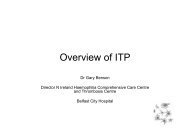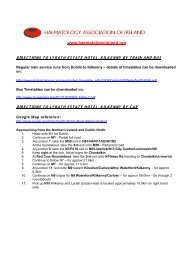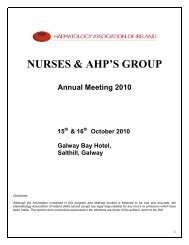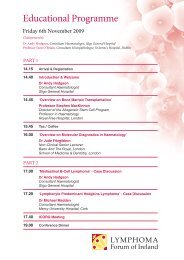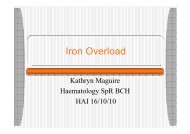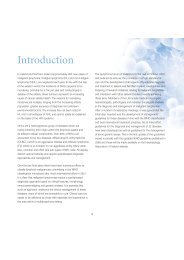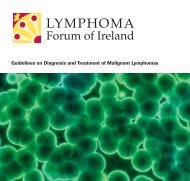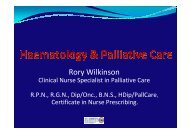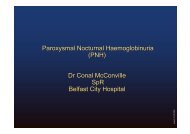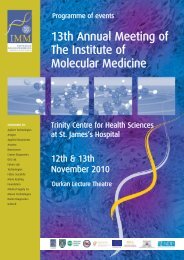Liz Higgins - Haematology Association of Ireland
Liz Higgins - Haematology Association of Ireland
Liz Higgins - Haematology Association of Ireland
You also want an ePaper? Increase the reach of your titles
YUMPU automatically turns print PDFs into web optimized ePapers that Google loves.
AutologousPeripheral<br />
Blood Stem Cell Harvest.<br />
<strong>Liz</strong> <strong>Higgins</strong><br />
BMT Co-ordinator<br />
St James’s Hospital, Dublin
National BMT/PBSCT<br />
Unit<br />
Allogenic<br />
Autologous PBSCT –<br />
GUH<br />
SVH<br />
Shared Care SJH - AMNCH,<br />
Beaumont, Mater hospitals.
PBSCH<br />
2008 71<br />
2009 75<br />
2010 54 to date
TEAM<br />
Referring Consultant<br />
Referring CNS<br />
Apheresis Team<br />
Cryobiology Team<br />
CNM<br />
Stem cell Transplant Co-Ordinators
PBSCT<br />
PBSCT involves eliminating an<br />
individual’s bone marrow stem cells.<br />
They are then replaced with bone<br />
marrow stem cells either from another<br />
individual or with a previously<br />
harvested portion <strong>of</strong> the individuals<br />
own bone marrow or peripheral blood<br />
stem cells.
Reasons for PBSCT<br />
Defective marrow function e.G. Aplastic<br />
anaemia, myelodysplasia, severe combined immune<br />
deficiency, sickle cell disease, and other benign<br />
inherited disorders<br />
Diseased marrow function e.G. Acute and<br />
chronic leukaemia<br />
To facilitate high dose therapy in<br />
other malignant conditions e.G.<br />
Lymphoma, testicular cancer, Multiple Myeloma.
Cancers treated by<br />
Autologous PBSCT<br />
Hodgkin,s disease<br />
Non Hodgkin's Lymphoma<br />
Chronic Myeloid Leukaemia<br />
Acute Myeloid Leukaemia<br />
Acute Lymphocytic Leukaemia<br />
Multiple Myeloma<br />
Testicular CA<br />
Ewing's Sarcoma.
Stem Cell<br />
Red Cell or White Cell or<br />
Platelet<br />
Once the ‘decision’ is made it is<br />
probably irreversible
Sources <strong>of</strong> Bone Marrow<br />
Stem Cells<br />
Bone marrow (BM) - aspirated from<br />
the posterior iliac crests under GA,<br />
usually 800-1200mls in volume<br />
Peripheral blood stem cells<br />
(PBSC) - following the administration<br />
<strong>of</strong> growth colony stimulating factor (G-<br />
CSF) + / - Chemotherapy
Autologous rescue involves two<br />
processes.<br />
PBSCH/ BMH<br />
PBSCT/ BMT
PBSCH<br />
COMMISSION DIRECTIVE 2006/17/EC<br />
<strong>of</strong> 8 February 2006<br />
implementing Directive 2004/23/EC <strong>of</strong><br />
the European Parliament and <strong>of</strong> the<br />
Council as regards<br />
certain technical requirements for the<br />
donation, procurement and testing <strong>of</strong><br />
human tissues and cells
Storage<br />
Liquid Nitrogen<br />
Stored in Vapour phase<br />
- 190 C<br />
15 Years
PBSC Mobilisation<br />
Initial Review<br />
FBC<br />
RLB Pr<strong>of</strong>ile<br />
Coagulation<br />
Blood group<br />
G&H<br />
Disease markers<br />
Virology – Hepatitis<br />
B,C; HIV 1&2; HTLV<br />
1&2; Syphilis<br />
Consider venous<br />
access –<br />
peripheral/central<br />
Medical assessment<br />
Nursing Assessment<br />
Counselling<br />
CXR/ ECG/ ECHO<br />
Consent<br />
Correspondence
Mobilisation Regimens<br />
G-CSF 10mcg/kg X 4 days<br />
IEV<br />
ICE<br />
Cyclophosphamide 2grms / M 2<br />
Ivac<br />
Dhap<br />
ESHAP<br />
Taxol / Ifos x 2<br />
VIDE
Cyclophosphamide<br />
2g/m 2<br />
Chemo on Monday<br />
Commence G-CSF (10mcg/Kg<br />
Tuesday)<br />
CD34 Count from day 8<br />
Leucapheresis day 8-10
GSCF ( Neupogen)<br />
10Mcg / kg Round up.<br />
Commence on Saturday.<br />
CD34 Count Tuesday +/- Gcsf<br />
PBSCH
ICE<br />
Etoposide 10mg/m 2 Day 1,2,3.,<br />
Carboplatin AUC 5 Day 2, Ifosfamide<br />
5000mg/m 2 24 hour infusion Day 2<br />
Neupogen 5 mcg/kg commence day 6<br />
Commence ICE on Thursday<br />
PBSCH 12-14 days Post<br />
Usually Wed for harvest
IEV / DHAP/ IVAC<br />
Wednesday<br />
PBSCH day 12-14
Eshap<br />
Commence Tuesday<br />
Day 12-14
Aphoresis<br />
Pending Peripheral CD34 Count x<br />
10 3 /ml<br />
(EDTA sample in lab for 8am)<br />
Monitored daily<br />
1-3 Days<br />
4-5 Hours<br />
Inpatient or Transfer as day patient
Apheresis guidelines
Pre harvest procedure<br />
Neutropenic<br />
Antibiotic therapy<br />
Throbcytopenia<br />
Platelet count > 30 for procedure<br />
Anaemia.<br />
HB > 8 for procedure<br />
Anticoagulation Therapy<br />
Drugs
COBE
Failure to Mobilise.<br />
2009 11 Patients failed to mobilise.
Autologous HSCT in<br />
multiple myeloma and lymphoma<br />
It is generally accepted that patients must collect a minimum <strong>of</strong> 2 x 10 6<br />
CD34+ cells/kg during apheresis to proceed with high dose<br />
chemotherapy and stem cell rescue.<br />
Patients who fail to collect this number <strong>of</strong> cells are usually considered<br />
mobilisation failures<br />
Current clinical practice involves remobilizing these patients with<br />
existing G-CSF or chemotherapy plus G-CSF regimens<br />
Menu
Risk factors for<br />
poor or failed mobilisation<br />
Advanced age<br />
Bone marrow involvement by tumour<br />
Extensive radiation to marrow sites<br />
Extensive prior therapy<br />
Mobilisation with G-CSF alone<br />
Previous treatment with alkylating agents<br />
Prior fludarabine or lenalidomide treatment<br />
General physical status<br />
Menu
Indication<br />
Plerixafor is indicated in combination with G-CSF to<br />
enhance mobilisation <strong>of</strong> haematopoietic stem cells to the<br />
peripheral blood for collection and subsequent autologous<br />
transplantation in patients with lymphoma and multiple<br />
myeloma whose cells mobilise poorly
Plerixafor: a first in class<br />
stem cell mobilising agent<br />
Structural formula <strong>of</strong> plerixafor 16<br />
Plerixafor is a first in class CXCR4 antagonist that mobilises stem<br />
cells from the bone marrow, increasing their number in peripheral<br />
blood<br />
Its mode <strong>of</strong> action is to block the chemokine receptor 4 (CXCR4, found<br />
on stems cells), preventing binding.<br />
Menu
Mechanism <strong>of</strong> action <strong>of</strong> Plerixafor<br />
Plerixafor blocks the CXCR4–SDF-1α interaction, releasing stem cells from<br />
the bone marrow into the circulating blood.<br />
Menu
The recommended dose <strong>of</strong> Plerixafor is 0.24mg/kg body weight/day. It should<br />
be administered by subcutaneous injection at a time that will allow an interval<br />
between dosing and the initiation <strong>of</strong> apheresis that is a minimum <strong>of</strong> 10 hours<br />
and a maximum <strong>of</strong> 11 hours.<br />
Gcsf at part <strong>of</strong> standard care – administered in the morning , and on the days <strong>of</strong><br />
apheresis, at least one hour prior to the initiation <strong>of</strong> apheresis.<br />
Plerixafor 10pm<br />
Gcsf 7am<br />
Apheresis 8.30am<br />
Menu
Plerixafor increases predictability <strong>of</strong><br />
apheresis yield and timing<br />
Menu
Numbers<br />
14 patients<br />
7 MM<br />
7 Lymphoma<br />
3 failures ( Lymphoma Pts)



